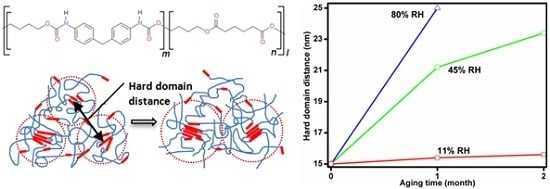Microstructure Changes in Polyester Polyurethane upon Thermal and Humid Aging
Abstract
:1. Introduction
2. Materials and Methods
2.1. Materials
2.2. Characterization
3. Results
3.1. Small-Angle Neutron Scattering (SANS)
3.2. Fourier Transform Infrared Spectroscopy (FTIR)
3.3. Gel Permeation Chromatography (GPC)
3.4. Differential Scanning Calorimetry (DSC)
4. Discussion
4.1. The Phase Morphology of Aged Estane
4.2. The Hydrogen Bonds and Thermal Behavior of Aged Estane
5. Conclusions
Acknowledgments
Author Contributions
Conflicts of Interest
References
- Prisacariu, C. Polyurethane Elastomers: From Morphology to Mechanical Aspects; Springer Verlag: Wien, Austria, 2011. [Google Scholar]
- Orler, E.B.; Wrobleski, D.A.; Smith, M.E. Hydrolytic degradation of Estane 5703. In Proceedings of the 22nd Aging, Compatibility and Stockpile Stewardship Conference, Oak Ridge, TN, USA, 27–30 April 1999.
- Orler, E.B.; Wrobleski, D.A.; Cooke, D.W.; Bennett, B.L.; Smith, M.E.; Jahan, M.S. Thermal Aging of Nitroplasticized Estane 5703. In Proceedings of the 24th Aging, Compatibility and Stockpile Stewardship Conference, Pantex, Amarillo, TX, USA, 29 April–3 May 2002.
- Salazar, M.R.; Lightfoot, J.M.; Russell, B.G.; Rodin, W.A.; McCarty, M.; Wrobleski, D.A.; Orler, E.B.; Spieker, D.A.; Assink, R.A.; Pack, R.T. Degradation of a poly(ester urethane) Elastomer. III. Estane 5703 Hydrolysis: Experiments and Modeling. J. Polym. Sci. Part A Polym. Chem. 2003, 41, 1136–1151. [Google Scholar] [CrossRef]
- Pierpoint, S.; Silverman, J.; Al-Sheikhly, M. Effects of ionizing radiation on the aging of polyester based polyurethane binder. Radiat. Phys. Chem. 2001, 62, 163–169. [Google Scholar] [CrossRef]
- Fambri, L.; Penati, A.; Kolarik, J. Synthesis and hydrolytic stability of model poly(ester urethane ureas). Angew. Makromol. Chem. 1995, 228, 201–219. [Google Scholar] [CrossRef]
- Thompson, D.G.; Osborn, J.C.; Kober, E.M.; Schoonover, J.R. Effects of hydrolysis-induced molecular weight changes on the phase separation of a polyester polyurethane. Polym. Degrad. Stab. 2006, 91, 3360–3370. [Google Scholar] [CrossRef]
- Mang, J.T.; Peterson, P.D.; Orler, E.B.; Wrobleski, D.A.; Langlois, D.A.; Espada, L.I.; Hjelm, R.P. Small-angle neutron scattering study of a thermally aged, segmented poly(ester urethane) binder. Neutron News 2003, 14, 26–28. [Google Scholar] [CrossRef]
- Espada, L.I.; Mang, J.T.; Orler, E.B.; Wrobleski, D.A.; Langlois, D.A.; Hjelm, R.P. Structural characterization of segmented polyurethanes by small angle neutron scattering. MRS Proc. 2001, 707. [Google Scholar] [CrossRef]
- Koberstein, J.T.; Galambos, A.F.; Leung, L.M. Compression-molded polyurethane block copolymers. 1. Microdomain morphology and thermomechanical properties. Macromolecules 1992, 25, 6195–6204. [Google Scholar] [CrossRef]
- Krakovský, I.; Bubenikova, Z.; Urakawa, H.; Kajiwara, K. Inhomogeneous structure of polyurethane networks based on poly(butadiene)diol: 1. The effect of the poly(butadiene) diol content. Polymer 1997, 38, 3637–3643. [Google Scholar]
- Krakovský, I.; Urakawa, H.; Kajiwara, K. Inhomogeneous structure of polyurethane networks based on poly (butadiene) diol: 2. Time-resolved SAXS study of the microphase separation. Polymer 1997, 38, 3645–3653. [Google Scholar]
- Koberstein, J.T.; Russell, T.P. Simultaneous SAXS-DSC study of multiple endothermic behavior in polyether-based polyurethane block copolymers. Macromolecules 1986, 19, 714–720. [Google Scholar] [CrossRef]
- Blundell, D.J.; Eeckhaut, G.; Fuller, W.; Mahendrasingam, A.; Martin, C. Real time SAXS/stress–strain studies of thermoplastic polyurethanes at large strains. Polymer 2002, 43, 5197–5207. [Google Scholar] [CrossRef]
- Mang, J.T.; Hjelm, R.P.; Orler, E.B.; Wrobleski, D.A. Small-angle neutron scattering of a solvent-swollen segmented polyurethane as a probe of solvent distribution and polymer domain composition. Macromolecules 2008, 41, 4358–4370. [Google Scholar] [CrossRef]
- Tian, Q.; Almásy, L.; Yan, G.; Sun, G.; Zhou, X.; Liu, J.; Rosta, L.; Chen, B. Small-angle neutron scattering investigation of polyurethane aged in dry and wet air. Express Polym. Lett. 2014, 8, 345–351. [Google Scholar] [Green Version]
- Keiderling, U. The new “BerSANS-PC” software for reduction and treatment of small angle neutron scattering data. Appl. Phys. A 2002, 74, s1455–s1457. [Google Scholar] [CrossRef]
- Breßler, I.; Kohlbrecher, J.; Thünemann, A.F. SASfit: A tool for small-angle scattering data analysis using a library of analytical expressions. J. Appl. Cryst. 2015, 48, 1587–1598. [Google Scholar] [CrossRef] [PubMed]
- Debye, P.; Anderson, R.; Brumberger, H. Scattering by an inhomogeneous solid. II. The correlation function and its application. J. Appl. Phys. 1957, 28, 679–683. [Google Scholar]
- Linliu, K.; Chen, S.A.; Yu, T.L.; Lin, T.L.; Lee, C.H.; Kai, J.J.; Chang, S.L.; Lin, J.S. A small-angle X-ray scattering study of microphase separation transition of polyurethanes: Effect of hard segments. J. Polym. Res. 1995, 2, 63–70. [Google Scholar] [CrossRef]
- Tian, Q.; Takács, E.; Krakovský, I.; Horváth, Z.E.; Rosta, L.; Almásy, L. Study on the microstructure of polyester polyurethane irradiated in air and water. Polymers 2015, 7, 1755–1766. [Google Scholar]
- Coleman, M.M.; Lee, H.H.; Skrovanek, D.J.; Painter, P.C. Hydrogen bonding in polymers. 4. Infrared temperature studies of a simple polyurethane. Macromolecules 1986, 19, 2149–2157. [Google Scholar] [CrossRef]
- Coleman, M.M.; Skrovanek, D.; Hu, J.; Painter, P.C. Hydrogen bonding in polymer blends. 1. FTIR studies of urethane-ether blends. Macromolecules 1988, 21, 59–65. [Google Scholar] [CrossRef]
- Luo, N.; Wang, D.N.; Ying, S.K. Hydrogen-Bonding properties of segmented polyether poly(urethane urea) copolymer. Macromolecules 1997, 30, 4405–4409. [Google Scholar] [CrossRef]
- Nierzwicki, W.; Majewska, Z. Swelling properties of urethane elastomers and their bearing on microphase separation. J. Appl. Polym. Sci. 1979, 24, 1089–1099. [Google Scholar] [CrossRef]
- Yanagihara, Y.; Osak, N.; Murayama, S.; Saito, H. Thermal annealing behavior and structure development of crystalline hard segment domain in a melt-quenched thermoplastic polyurethane. Polymer 2013, 54, 2183–2189. [Google Scholar] [CrossRef]
- Li, X.; Stribeck, A.; Schulz, I.; Pöselt, E.; Eling, B.; Hoell, A. Nanostructure of thermally aged thermoplastic polyurethane and its evolution under strain. Eur. Polym. J. 2015. Available online: http://dx.doi.org/10.1016/j.eurpolymj.2015.11.027 (Accessed on 14 May 2016). [Google Scholar]
- Princi, E.; Vicini, S.; Stagnaro, P.; Conzatti, L. The nanostructured morphology of linear polyurethanes observed by transmission electron microscopy. Micron 2011, 42, 3–7. [Google Scholar] [CrossRef] [PubMed]
- Gardner, R.J.; Martin, J.R. Effect of relative humidity on the mechanical properties of poly (1,4-butylene terephthalate). J. Appl. Polym. Sci. 1980, 25, 2353–2361. [Google Scholar] [CrossRef]
- Vermette, P.; Griesser, H.J.; Laroche, G.; Guidoin, R. Biomedical Applications of Polyurethanes; Landes Bioscience: Georgetown, TX, USA, 2001. [Google Scholar]
- Schoonover, J.R.; Thompson, D.G.; Osborn, J.C.; Orler, E.B.; Wrobleski, D.A.; Marsh, A.L.; Wang, H.; Ralmer, R.A. Infrared linear dichroism study of a hydrolytically degraded poly(ester urethane). Polym. Degrad. Stab. 2001, 74, 87–96. [Google Scholar] [CrossRef]
- Li, Y.; Gao, T.; Liu, J.; Linliu, K.; Desper, C.R.; Chu, B. Multiphase structure of a segmented polyurethane: Effects of temperature and annealing. Macromolecules 1992, 25, 7365–7372. [Google Scholar] [CrossRef]

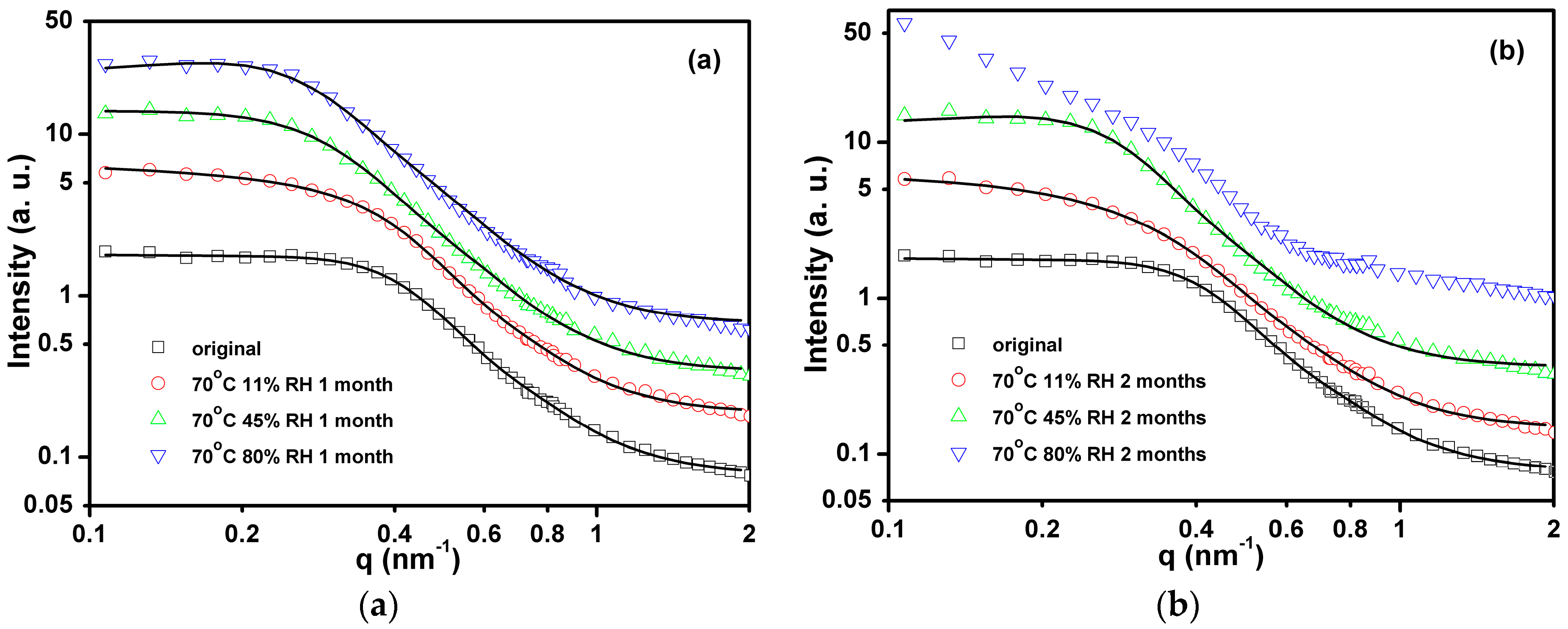
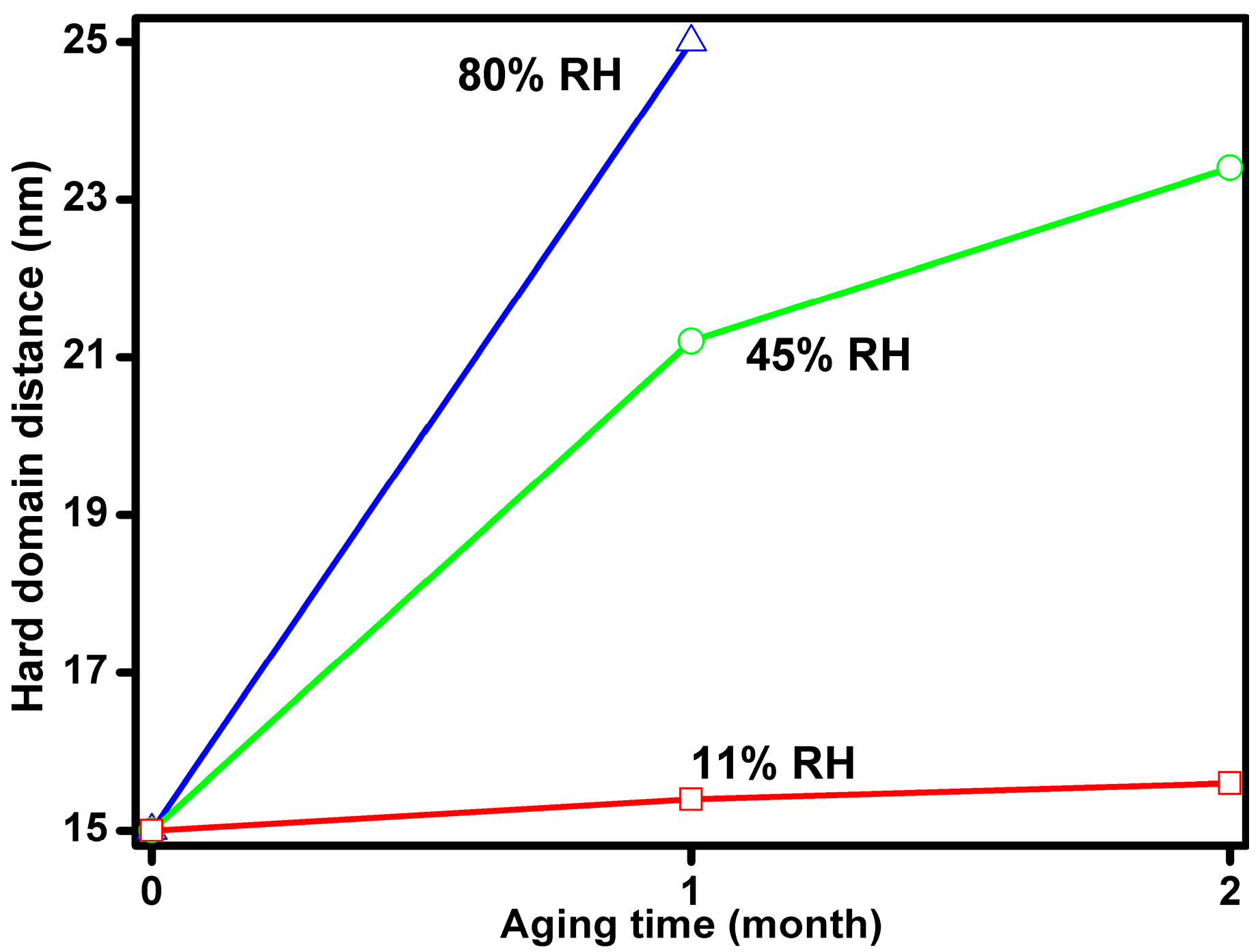
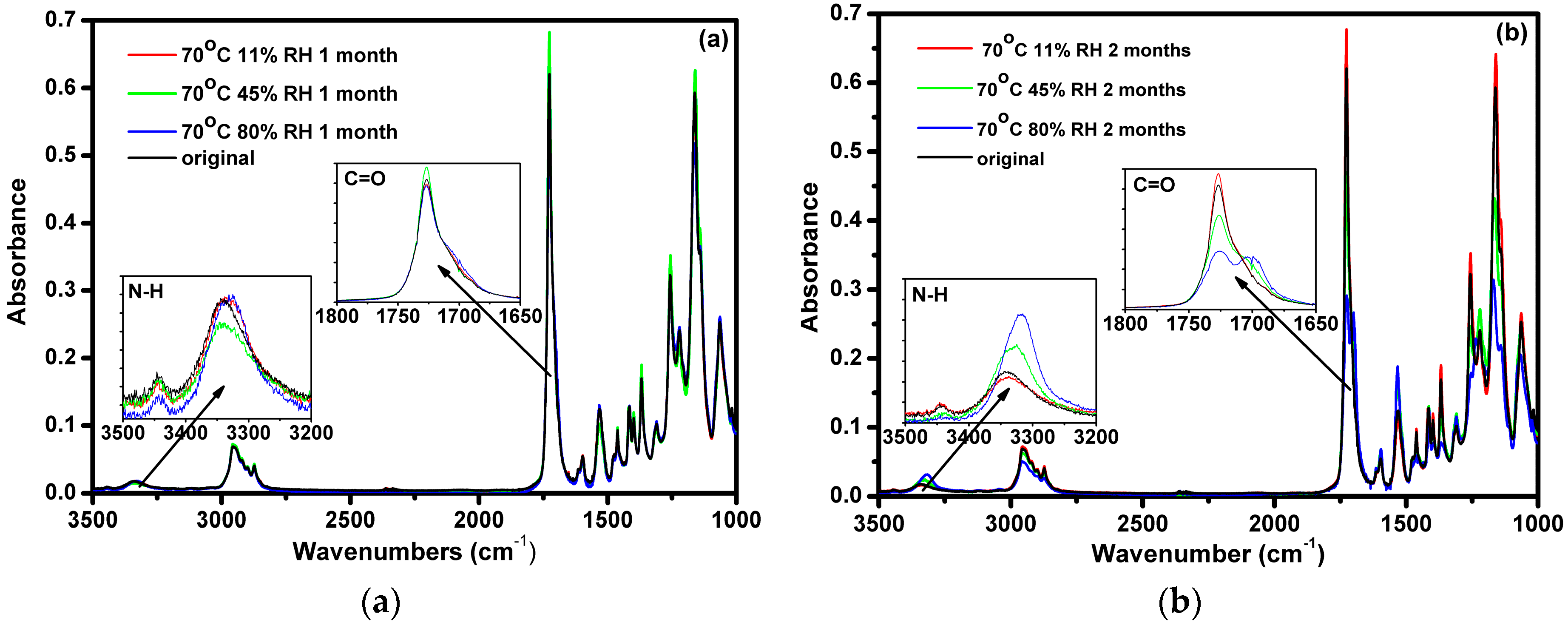
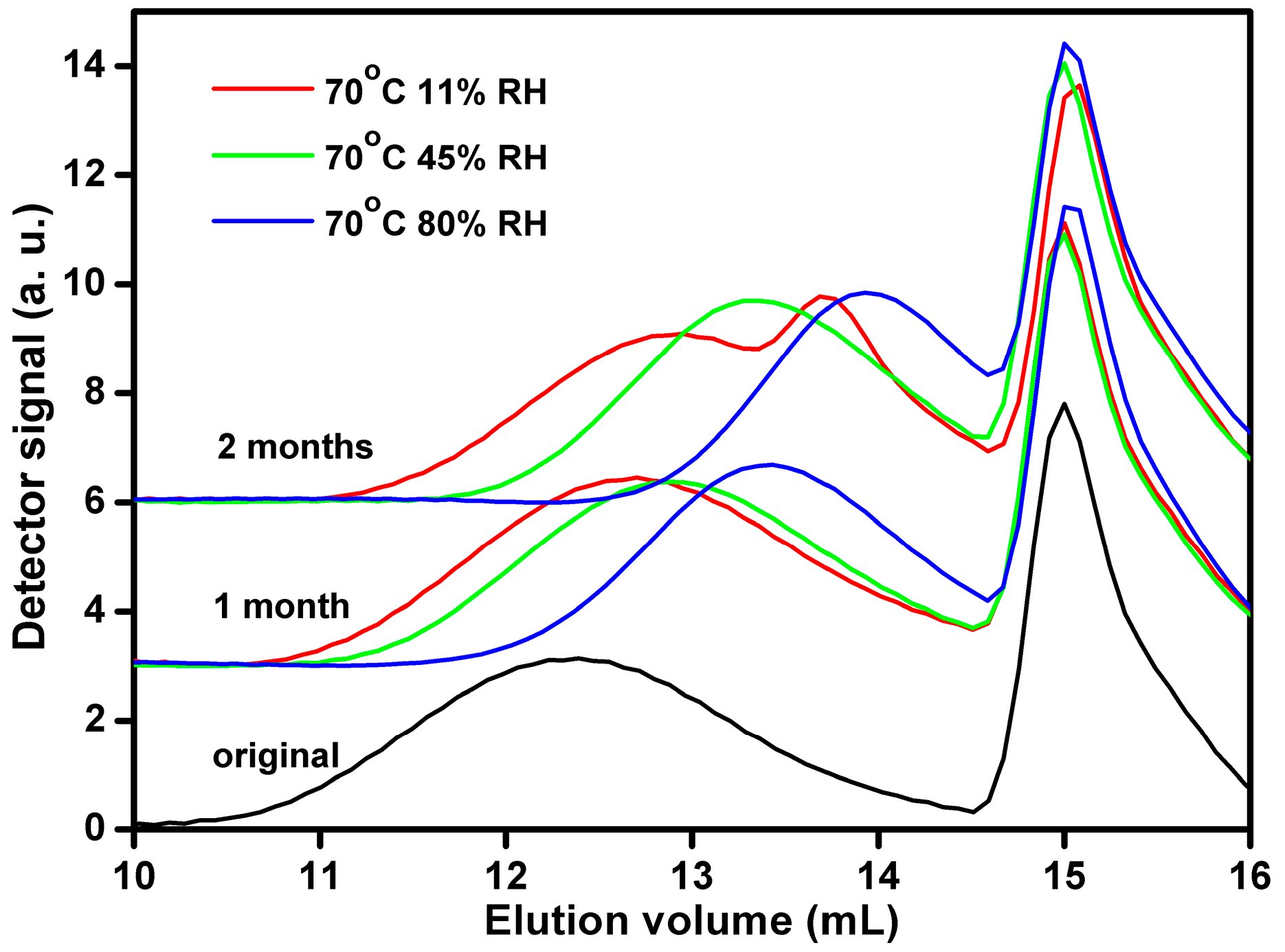
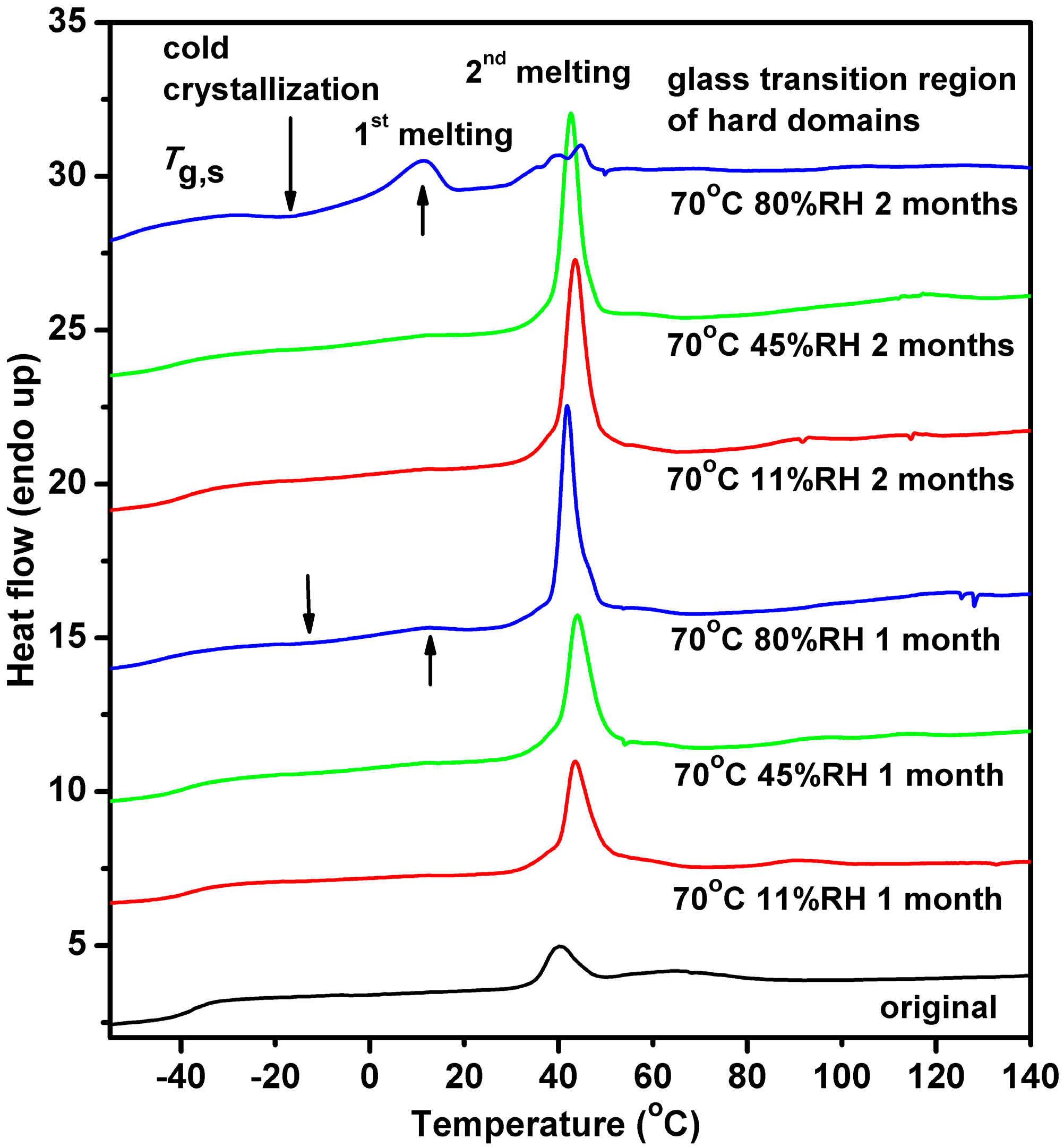
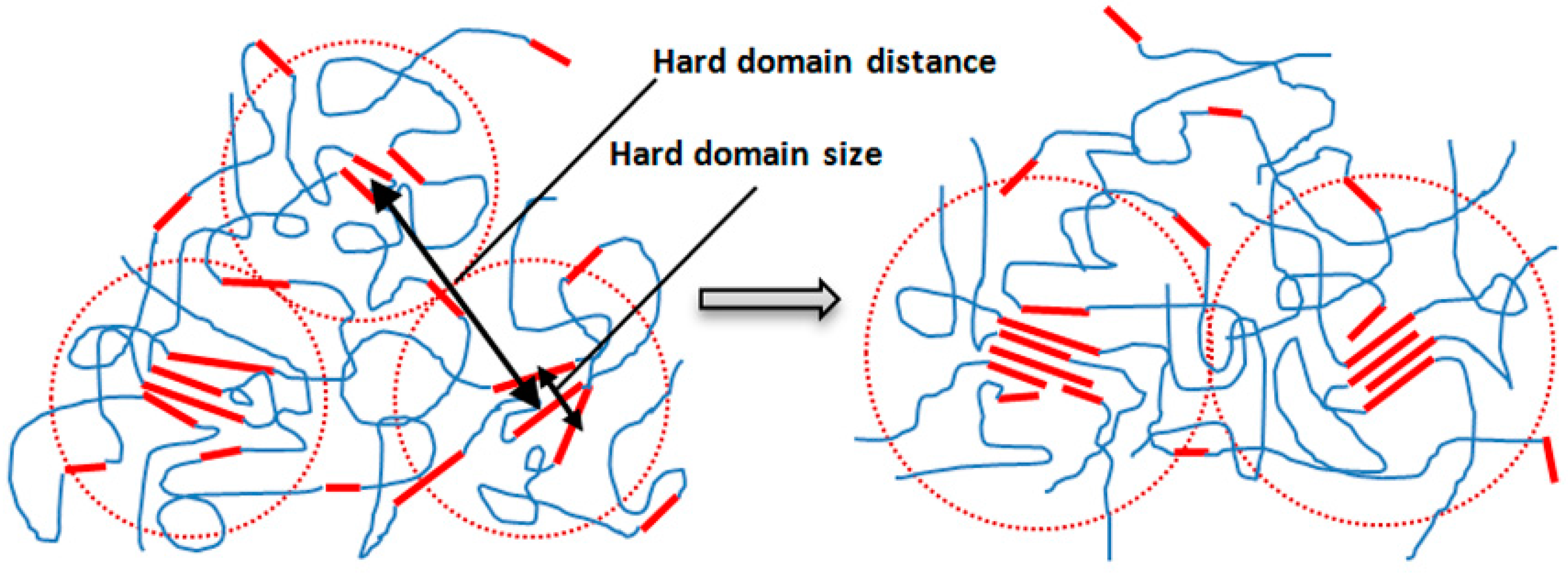
| Samples | RHS (nm) | acor (nm) | v | v/RHS3 (nm−3) |
|---|---|---|---|---|
| original | 7.46 ± 0.05 | 3.07 ± 0.02 | 0.165 ± 0.003 | 4.0 × 10−4 |
| 70 °C 11% RH 1 month | 7.69 ± 0.07 | 3.52 ± 0.03 | 0.136 ± 0.003 | 3.0 × 10−4 |
| 70 °C 45% RH 1 month | 10.58 ± 0.19 | 3.71 ± 0.02 | 0.128 ± 0.006 | 1.1 × 10−4 |
| 70 °C 80% RH 1 month | 12.46 ± 0.21 | 3.87 ± 0.02 | 0.173 ± 0.008 | 0.9 × 10−4 |
| 70 °C 11% RH 2months | 7.82 ± 0.14 | 3.66 ± 0.07 | 0.098 ± 0.005 | 2.0 × 10−4 |
| 70 °C 45% RH 2 months | 11.70 ± 0.11 | 4.65 ± 0.04 | 0.184 ± 0.007 | 1.0 × 10−4 |
| 70 °C 80% RH 2 months | – | – | – |
| Sample | Mn (g/mol) | Mw (g/mol) | Mw/Mn |
|---|---|---|---|
| Original | 33,000 | 120,000 | 3.6 |
| 70 °C 11% RH 1month | 17,200 | 58,000 | 3.4 |
| 70 °C 45% RH 1month | 11,000 | 34,000 | 3.1 |
| 70 °C 80% RH 1month | 3,400 | 13,200 | 3.9 |
| 70 °C 11% RH 2months | 9,500 | 36,000 | 3.8 |
| 70 °C 45% RH 2months | 4,400 | 10,400 | 2.4 |
| 70 °C 80% RH 2months | 1,750 | 2,500 | 1.4 |
| Samples | Tg,s (°C) | Texo (°C) | T1 (°C) | Δh1 (J/g) | T2 (°C) | Δh2 (J/g) | T3 (°C) | Δh3 (J/g) |
|---|---|---|---|---|---|---|---|---|
| original | −37.6 | - | - | - | 33 | 6 | - | 9 |
| 70 °C 11% RH 1 month | −38.1 | - | - | - | 32 | 20 | 80 | 1.4 |
| 70 °C 45% RH 1 month | −39.1 | - | - | - | 30 | 23 | 82 | 2.2 |
| 70 °C 80% RH 1 month | −39.2 | −20 | −5 | 1.3 | 28 | 29 | 90 | 4.7 |
| 70 °C 11% RH 2 months | −41.4 | - | - | - | 30 | 24 | 75 | 2.8 |
| 70 °C 45% RH 2 months | −44.1 | - | - | - | 30 | 28 | 82 | 4.5 |
| 70 °C 80% RH 2 months | −51.0 | −30 | −5 | 10 | 28 | 20 | 90 | 8.1 |
© 2016 by the authors. Licensee MDPI, Basel, Switzerland. This article is an open access article distributed under the terms and conditions of the Creative Commons Attribution (CC-BY) license ( http://creativecommons.org/licenses/by/4.0/).
Share and Cite
Tian, Q.; Krakovský, I.; Yan, G.; Bai, L.; Liu, J.; Sun, G.; Rosta, L.; Chen, B.; Almásy, L. Microstructure Changes in Polyester Polyurethane upon Thermal and Humid Aging. Polymers 2016, 8, 197. https://doi.org/10.3390/polym8050197
Tian Q, Krakovský I, Yan G, Bai L, Liu J, Sun G, Rosta L, Chen B, Almásy L. Microstructure Changes in Polyester Polyurethane upon Thermal and Humid Aging. Polymers. 2016; 8(5):197. https://doi.org/10.3390/polym8050197
Chicago/Turabian StyleTian, Qiang, Ivan Krakovský, Guanyun Yan, Liangfei Bai, Jiahui Liu, Guangai Sun, László Rosta, Bo Chen, and László Almásy. 2016. "Microstructure Changes in Polyester Polyurethane upon Thermal and Humid Aging" Polymers 8, no. 5: 197. https://doi.org/10.3390/polym8050197





